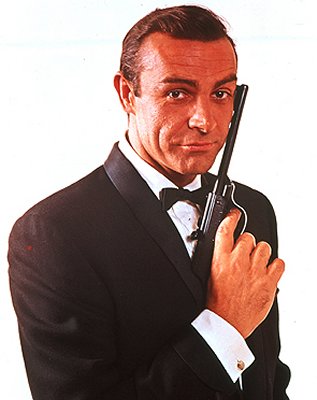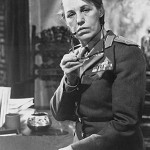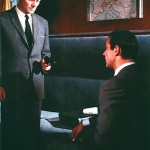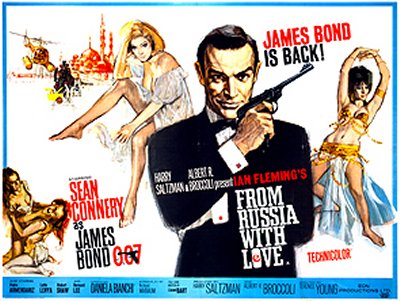 After the success of the first James Bond movie Dr. No and rising star Sean Connery, United Artists quickly greenlit the return of 007. The EON producers Albert R. Broccoli and Harry Saltzman soon swung into action. They had already chosen Ian Fleming’s fifth bestselling James Bond thriller From Russia, With Love (1957) as the second big-screen 007 adventure, with Terence Young back again as the director.
After the success of the first James Bond movie Dr. No and rising star Sean Connery, United Artists quickly greenlit the return of 007. The EON producers Albert R. Broccoli and Harry Saltzman soon swung into action. They had already chosen Ian Fleming’s fifth bestselling James Bond thriller From Russia, With Love (1957) as the second big-screen 007 adventure, with Terence Young back again as the director.
Already highly rated by many Bond aficionados, From Russia, With Love (1963) has recently been recognised by the British Film Institute (BFI) as a film classic. In view of this, the BFI has published a new book on the movie by the film historian Llewella Chapman, as part of the ‘BFI Film Classics’ series. In light of this well-deserved accolade, the JBIFC takes the opportunity to offer (00)7 pieces of info about the second James Bond film, some facts familiar, others less so.
The movie often rates very highly in polls of favourite Bond films, and many critics rate it as something of a ground-breaking film, very much in the mould of Hitchcock and also with a touch of film noir in its atmosphere, especially in the night-time scenes set on the Orient Express. It was also pretty faithful to Fleming’s novel.
The choice of Ian Fleming’s fifth book as the second big-screen 007 thriller was possibly influenced by the fact that the new U.S. President J.F. Kennedy had become a Bond fan and, in 1961, had listed From Russia as one of his favourite top ten books.
To help celebrate the second James Bond movie, which premiered on 10th October, 1963, and broke box-office records at the time, the JBIFC looks back briefly on From Russia, With Love (FRWL) and, in seven bite-sized portions, some of the main characters and moments that made it into such a memorable entry in the franchise.
007 and Counting…
001: Johanna Harwood, who had worked on the screenplay for Dr. No, was soon commissioned by Harry Saltzman to pen a treatment for FRWL, which she completed in August, 1962. However, she became unhappy with interference by Terence Young in her draft and eventually left the production. Not many people realise that spy novelist Len Deighton (author of The Ipcress File, a book praised by Ian Fleming) was then asked to take over and redraft Harwood’s work. Deighton worked briefly on the movie adaptation of From Russia, before Richard Maibaum then fleshed out the main screenplay. Interestingly, Deighton returned to the world of Bond script-writing in the mid-1970s, when he worked with Kevin McClory and Sean Connery on James Bond of the Secret Service, the project that eventually became Connery’s unofficial Bond comeback.
002: Some excellent casting decisions were made by Terence Young and his team for FRWL. The critically acclaimed stage actress Lotte Lenya was chosen for the role of the truly creepy Russian Colonel Rosa Klebb; the novelist and relatively unknown actor Robert Shaw was selected for the key role of ‘Red’ Grant, and had very impressive physical presence; and the famous Mexican character actor Pedro Armendariz was given the role of Kerim Bey, one of the most colourful characters in Fleming’s novel. He did a superb job.

003: Principal photography on the movie commenced at Pinewood Studios on 1st April, 1963. Director Terence Young utilised not just studio interiors at the famous Pinewood Studios complex, but also various exteriors in the surrounding grounds. This included the Pinewood Studios mansion and gardens at night (eventually used in the pre-credits of FRWL at the suggestion of editor Peter Hunt) and the same gardens (dubbed the ‘Renaissance Gardens’ in the FRWL shooting script) were used during the day (for the scenes involving Robert Shaw, Lotte Lenya and Walter Gotell on SP.E.C.T.R.E. Island). Producer Harry Saltzman apparently also suggested that the SP.E.C.T.R.E. training camp on the Island could be modelled on the famous gladiator school scene that appeared in Stanley Kubrick’s movie Spartacus (1960).
004: When the crew moved to Istanbul for key location shooting in late April, 1963, the movie faced a series of logistical and production challenges. Director Terence Young initiated a number of key changes to the Maibaum and Harwood script, while the shooting also attracted large numbers of local onlookers, curious about the movie and its scenes. There were also delicate negotiations that had to be carried out with various railway officials and trade union representatives.This caused various delays to filming. Bond author Ian Fleming also paid a visit to the filming in Istanbul and, at one point, witnessed the five hundred rats (which Bond and Tatiana encounter in the sewers) break free from the crew’s control, much to the alarm of the film-makers. Director Terence Young decided to shoot part of the rats scene again, towards the end of filming in August, and this time in Madrid. Again, it proved quite a challenge, and a number of the crew ended up standing on chairs after some of the rats escaped!
005: While on location in Turkey it also became clear to Terence Young that Pedro Armendariz appeared to be suffering in the heat, but was putting on a brave face and was trying to carry on as normal; when Young took him aside and raised concerns for his well-being, Armendariz confessed that he was dying of cancer. He begged Young to allow him to continue. Young was shocked but he and the producers managed to conceal the reality from the studio executives. They rearranged the shooting schedule so that the Mexican actor could quickly complete his scenes back at Pinewood (he finished them on 8th June, and tragically committed suicide on 18th June, 1963, not long after completing his work on the movie). During filming in Scotland, where key scenes were shot for the helicopter and speedboat chase scenes, the director himself narrowly avoided a tragedy when the helicopter carrying Young and his art director Michael White got into difficulty.

006: Shooting on the movie was completed on 23rd August, 1963, and Peter Hunt, the movie’s editor, basically had less than two months to get a final cut in place before it was to be premiered! He did some sterling work. What arguably makes FRWL especially memorable is the way that Hunt (who later directed On Her Majesty’s Secret Service) began to increasingly experiment with and use a very rapid quick-cut editing style, something that he employed to full effect on his next James Bond projects. This distinctive action film editing technique was prominently on display in the now-famous fight scene on the Orient Express between James Bond and ‘Red’ Grant, a pulse-raising fight scene which left cinema audiences and film critics dazzled at the time. Indeed, film historians have argued that Hunt’s pioneering editing style had an enormous influence on numerous film-action editors for years afterwards, something Hunt’s obituaries noted when he sadly passed away in 2002.
007: The film played to packed cinemas in the UK and, in nearly every market abroad, saw unprecedented queues of cinema-goers waiting patiently for each screening. It made an astonishing $78.9 worldwide, a huge sum at the time. When a special double-bill feature of Dr. No and From Russia, With Love was reissued to coincide with Goldfinger, the two movies once again broke box-office records. In many ways, the ‘Bond-mania’ of the 1960s had well and truly arrived. Llewella Chapman argues in her new book that FRWL ‘should be recognised as the most creatively suspenseful and thrilling film in the Bond series, and is deserving of its well-earned place within the BFI Film Classics series in its own right’. She has a strong case.
Did You Know?
When Bond author Ian Fleming visited the location shooting for From Russia in Istanbul, he met Pedro Armendariz (Kerim Bey) for the first time and, according to later comments by Terence Young, the Bond author and Mexican actor ‘took a considerable liking to one another’ and chatted for hours. Fleming met Armendariz just once again – on 9th June, 1963, at a special going away party for Armendariz (he was due for medical treatment in America) held in London and organized by Young. Armendariz died on 18th June in Mexico.

